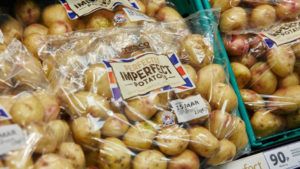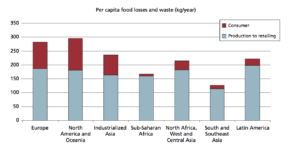Feeding the world one ugly potato at at time!

How one grocer revolutionized their food supply chain to save money and feed the hungry.
Food Waste Implications
The inefficient management of food has dire environmental effects including increased land degradation, greenhouse gas emissions, and deforestation [1]. According to the Food and Agriculture Organization of the United Nations (FAO), roughly one-third of food produced for human consumption is lost or wasted globally, which amounts to about 1.3 billion tons per year [2].
Companies involved in the food supply chain are affected by food waste in many ways. Firstly, food production is costly and waste cuts into all of the stakeholders’ already slim margins. For example, food waste reduction lowers artificial demand, which in turn lowers unnecessary production, allowing the supplier to produce at the lowest cost possible, the distributor and grocer to purchase at a lower price, and in the end for consumers to pay less for the food they are buying [3]. The business case for reducing food waste sells itself; research across multiple industries focused on buying or selling food has shown that 99% of times a business invests in reducing food waste, they saw a positive return on investment and half of these businesses had a minimum $14 return for every dollar invested [4].
Last but not least, businesses have an ethical duty to the communities they serve and the environment from which they benefit. Reducing waste lowers their use of limited natural resources and certain initiatives, like food donation programs, allow them to give back to those less fortunate.
Source: FAO [5]
Tesco: A Pioneer in Food Supply Chain Optimization
Tesco, a large British multinational grocery retailer, has chosen to address these issues head on by setting a target to halve food waste in their operations by 2030 [6]. Their actions have targeted aspects of the food supply chain at every junction.
Tesco has worked with local non-profit organizations to donate excess food from their stores, resulting in over 5,900 tons of food diverted from waste since 2012 [7]. They have recently launched an innovative partnership with social enterprises FareShare and FoodCloud to allow stores to alert charities to the amount of surplus food they have at the end of each day through an app [8].
Variation in harvest sizes from season to season is a sizeable contributor to food waste. Tesco has adopted two main tactics to accommodate this variability. First, they have merged their fragmented supply processes to put this food to good use. Potatoes that are either in excess of consumer demand or deemed too “ugly” to sell are redirected to Tesco’s own private brand product development and sold as pre-made mashed potatoes [9]. To further help normalize demand for growers and adapt to different harvest outputs, Tesco will sell larger packages of produce at a lower price per unit. This helps reduce potential waste, and also allows consumers to get a better deal, thereby building brand loyalty and trust.

Source: Tesco [10]
Behaving as the industry leader that it is, Tesco has committed to helping their suppliers improve in the long-term. In September 2017, Tesco announced it had put in place partnership agreements with 24 of its largest food suppliers. These key suppliers will publish food waste data for their own operations over the next year and through Tesco’s willingness to share best practices, will look to reduce food waste in their own supply chain [11].
Continuing the revolution at Tesco
While I am impressed by Tesco’s current efforts, I believe many opportunities remain untapped. Their current programs make no mention of improvements in their own distribution network. Lack of maintained cold chain integrity can cause loss of quality, thereby forcing retailers to dispose of produce due to food safety concerns. An investment in equipment and technology may be required to improve performance in cold chain management, but issues are often related to subpar processes.
Furthermore, overhauling their existing distribution strategy to shorten the food supply chain would also reduce waste. Many retailers developed their distribution plans when the company was founded and have not adapted it to offset for urbanization and changes in demand location. Opportunities likely exist for Tesco to overhaul their distribution network and make sure each item is taking the shortest route possible from farm to store, increasing its chances of being bought and consumed while still in safe condition.
What’s next?
What responsibilities do retailers have towards the environment and their communities? Most currently take without giving back.
How much of the issues are caused by multinationals, and should consumers look to buy local in order to combat climate change?
How can Tesco and others prepare for the future? Higher weather variations, technological advances, and a growing and hungry third world are the main challenges I envision.
(Word Count: 771 words)
Sources:
[1] Nellman et al. “The Environmental Food Crisis: The Environment’s Role in Averting Future Food Crises”, United Nations Environment Programme (UNEP), 2009, http://old.unep-wcmc.org/medialibrary/2010/09/07/51d38855/FoodCrisis.pdf, accessed November 2017.
[2] FAO. “Global food losses and food waste – Extent, causes and prevention”, 2011, http://www.fao.org/docrep/014/mb060e/mb060e00.pdf, accessed November 2017.
[3] Ventour, Lorrayne. “Household Food and Drink Waste in the UK; Waste & Resources Action Programme (WRAP)”, 2008, http://www.wrap.org.uk/sites/files/wrap/Household_food_and_drink_waste_in_the_UK_-_report.pdf, accessed November 2017.
[4] Hanson, Craig and Mitchell, Peter. “The Business Case for Reducing Food Loss and Waste”, 2017, https://champions123.org/wp-content/uploads/2017/03/report_-business-case-for-reducing-food-loss-and-waste.pdf, accessed November 2017.
[5] FAO. “Global food losses and food waste – Extent, causes and prevention”.
[6] Tesco. “Actions and Targets,” https://www.tescoplc.com/little-helps-plan/products-food-waste/actions-and-targets/, accessed November 2017.
[7] Tesco. “Food Collection,” https://www.tesco.com/food-collection/, accessed November 2017.
[8] Tesco. “Food Collection”.
[10] Tesco. “7 ways Tesco is offering little helps for a healthier life,” https://www.tescoplc.com/news/blogs/topics/tesco-health-action-for-customers/, accessed November 2017
[10] Tesco. “Food Collection”.
[11] Tesco. “Tesco suppliers join forces to tackle global food waste,” https://www.tescoplc.com/news/news-releases/2017/food-waste-suppliers-champions-123-dave-lewis-tesco/, accessed November 2017.




This is an intriguing article, and I believe very forward-thinking of Tesco. I agree that food waste is a large issue and greatly contributes to climate change. However, I did take issues with the larger pack sizes of produce. This may reduce waste at the store level, but have any tests been done to see if it will reduce waste at home? It seems like the larger pack sizes will just shift the food waste to the consumer. Perhaps Tesco needs to re-evaluate its purchasing methods and buying strategy. Is it buying too much produce in a given location? How can it use produce about to be wasted, not just the ugly potatoes? Tesco is making changes, but I think these are very small and insignificant compared to the problem. I expect more from a company as large as Tesco.
Cool article! Great to look at minimizing food waste. Instead if purely redirecting “ugly” produce to different brands under the same conglomerate, one exciting initiative I recently learned about is a startup called “Imperfect Produce” that does just what it sounds like, delivers produce deemed too unseemly to sell to its customer base at discounts of 30-50% from grocery store markups.
Even though enterprising solutions like this are popping up in hopes of mitigating the waste at the *end* of the supply chain, I agree that another megatrend, technology, must be used *along* the chain in order to shorten the chain and reduce the time from soil to table, meaningfully reducing waste and spoilage.
Thanks for writing about such an important topic! I do think retailers have the responsibility to focus on this issue, much like Tesco is doing. I think Tesco needs to do a better job, however, of working with consumers as waste must be considered end to end. For example, a couple points you highlighted that Tesco is doing to improve on this problem are donating more food to charity organizations and also packaging in larger bulk packages with a lower overall cost to the consumer. However, both of these “improvements” seem to pass the buck onto the consumer. Charities will definitely use some of the food but some may still go to waste and it’s important that this is measured and considered. Also, consumers may buy more in bulk but then have more waste because they didn’t need to buy so much. So while these improvements help some, I think it’s important to not overvalue the improvement and rather to look at the overall waste cradle to grave.
I do think that consumers should try to buy more locally as the distribution can cause a lot of losses throughout the whole process. It’s important that when buying local that the local processes are still efficient though. If the local production is not efficient, it could have a negative impact on climate change. I do think that Tesco must also look towards the future and invest in areas that might be better suited for production and distribution when taking into account changes from global warming, as well as trying to partner with organizations that invest in preventing climate change.